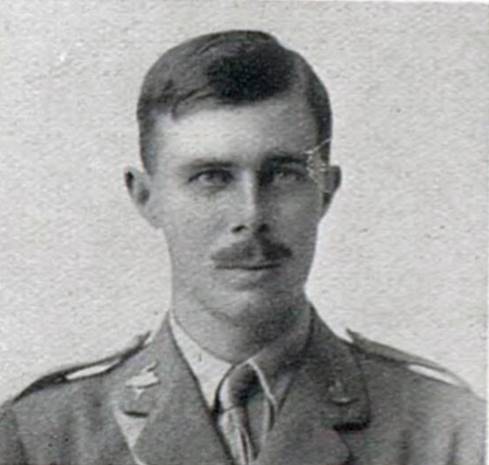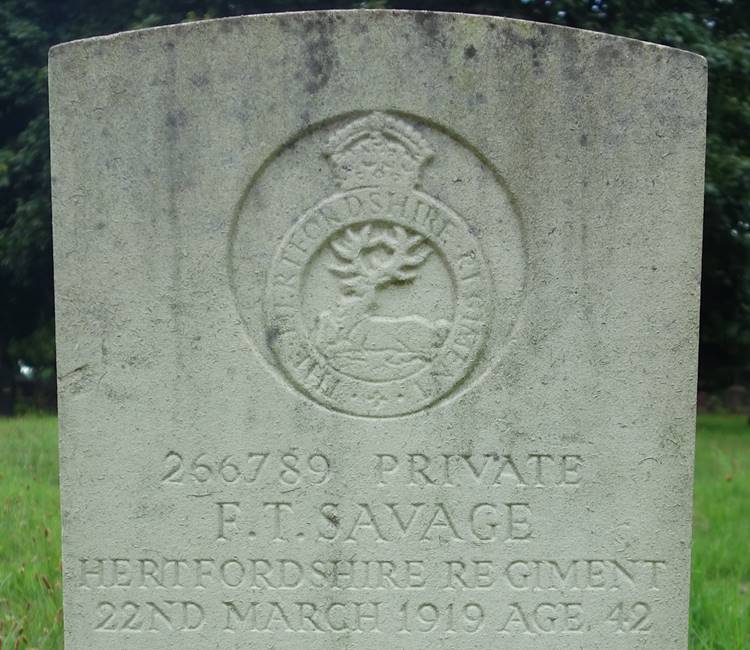This article looks at the Hertfordshire Regiment during the First World War and will help you research the soldiers who served with it. This page is one of my guides to help you research soldiers who served in the British Army:
The Hertfordshire Regiment in the First World War
The Hertfordshire Regiment was a Territorial Force regiment which consisted of a single battalion on the outbreak of war. The Regiment had its headquarters at Hertford and was part of the East Midland Brigade of the East Anglian Division. It recruited its soldiers from the following areas pre-war:
- A Company: Hertford, Watton, Hatfield and Berkhamsted
- B Company: St Albans, London Colney and Harpenden
- C Company: Bishop’s Stortford, Sawbridgeworth, Braughing, Widford, Ware and Wadesmill
- D Company: Watford and Chorley Wood
- E Company: Royston, Letchworth, Baldock and Ashwell
- F Company: Hemel Hempstead, Great Berkhamsted, Asheridge, Tring and Ivinghoe
- G Company: Hitchin, Welwyn, Stevenage, Whitwell
- H Company: Waltham Cross, Wormley, Cheshunt and Hoddesdon
The Commonwealth War Graves Commission recorded that between 7 November 1914, the Regiment’s first death during the war and 11 November 1918, the Hertfordshire Regiment suffered 812 dead.
1/1st Battalion The Hertfordshire Regiment
After the declaration of war, the Battalion was embodied and moved to Bury St Edmunds. At the time, it was serving as part of the East Midland Brigade of the East Anglian Division. In September, the Battalion formed a second-line unit and became the 1/1st Battalion. Though, it is often referred to as the 1st Battalion. On 6 November 1914, the Battalion landed in France where on 20 November, it joined the 4th (Guards) Brigade of the 2nd Division. On 19 August 1915, the Battalion joined the 6th Brigade which was also part of the 2nd Division in which it remained until 29 February 1916 when it joined the 118th Brigade of the 39th Division. On 8 February 1918, the Battalion transferred to the 116th Brigade of the 39th Division, before joining the 112th Brigade of the 37th Division on 11 May 1918. On 22 May 1918, the Battalion absorbed thirty officers and 650 other ranks of the 6th Battalion The Bedfordshire Regiment.
2/1st Battalion The Hertfordshire Regiment
The 2/1st Battalion was raised at Hertford in September 1914 as the Hertfordshire Regiment’s second-line battalion. In January 1915, the Battalion moved to Newmarket and joined the 207th Brigade of the 69th Division. In November 1915, the unit formed the 4/1st Battalion. In June 1916, the Battalion moved to Harrogate, then to Darlington in October and to Carburton Camp, Nottinghamshire in April 1917. On 20 September 1917, the 2/1st Battalion was disbanded.
3/1st Battalion The Hertfordshire Regiment
The 3/1st Battalion was raised at Hertford in December 1914 and by October 1915, had moved to Halton Camp, Tring. On 8 April 1916, it was redesignated as the 1st Reserve Battalion, part of the East Anglian Reserve Brigade while still at Halton Camp. On 11 July 1917, the Battalion was combined with the 5th Reserve Battalion The Bedfordshire Regiment while still at Halton.
4/1st Battalion The Hertfordshire Regiment
The 4/1st Battalion was formed by the 2/1st Battalion at Thetford, Norfolk in November 1915 and joined the 206th Brigade of the 69th Division. In July 1916, the Battalion moved to Harrogate, then to Welbeck in April 1917. The Battalion was disbanded in August 1917.
Researching Soldiers who Served with the Hertfordshire Regiment the First World War
Start off with my generic guides to researching soldiers who served in the British Army, especially those concerning medal records and abbreviations and acronyms. You’ll encounter a lot of military jargon in your research. The most important source of information for the Regiment during the war is its war diaries which are unfortunately quite poor. I’d therefore also recommend looking at the brigade headquarters’ war diaries for additional information. Many newspapers covering Hertfordshire during the war have been digitized and can be searched on Findmypast. Local newspapers are the best chance to find a photograph of a soldier.
Officers: A service record is the most important document to find but not all have survived. If a service record has survived it will either be at the National Archives or if an officer served past April 1922 with the Ministry of Defence. There are over 150 officer service records for the Hertfordshire Regiment at the National Archives. If an officer served past April 1922 then have a look at my article on ordering service records from the Ministry of Defence. Officers are mentioned throughout the 1/1st Battalion’s war diaries. If you’re researching an officer who became a casualty, I’d highly recommend looking at local newspapers, especially if you’re trying to find a photograph of them. For the date an officer was commissioned and his subsequent promotion dates, look at the London Gazette, Hart’s Army List and Army Lists.
This photograph shows Lieutenant Harcourt John Snowden who was killed in action on 11 January 1915 and is buried in the Rue-des-Berceaux Military Cemetery, Richebourg-L’Avoue. Harcourt wears the collar badge of the Hertfordshire Regiment which was a Hart, an adult male deer, crossing a ford. A small T denotes the Territorial Force. This photograph was published in The Sphere which is an excellent newspaper to search if you’re looking for a photograph of an officer who died during the war. This newspaper has been digitized and is available to view on Findmypast. There is a service record for Snowden at the National Archives which would be an important source of information if you wanted to research him.
Other Ranks: A service record is the most important document for researching a soldier who served in the ranks but many were destroyed in the Blitz. If a service record has survived and the soldier in question left the army prior to January 1921, you’ll be able to find it online. If a soldier served past January 1921, then in theory, their service record should still be held by the Ministry of Defence. Ordering a copy is straightforward: Ordering service records from the Ministry of Defence. Providing a soldier served outside of Britain and Ireland, there will be at least two medal records to consult. These may be the only surviving documents to confirm a soldier’s service. Due to the large number of casualties sustained by the Regiment on the Western Front, you should also search casualty lists.
The headstone for Private Francis Thomas Savage who served with the Hertfordshire Regiment during the war. Francis was from Ware, Hertfordshire and enlisted on 6 July 1915. Only a small part of Francis’ service record has survived but it includes an Army Form Z.11 Statement As To Disability. This was a demobilization document where a soldier could make a claim “in respect of a Disability due to Military Service”. Francis’ form was dated 31 January 1919 and it reported he was suffering from “tubercular caries of spine, with compression of the spinal cord”. Unable to walk or stand, this is almost certainly what killed Francis less than two months later. A death certificate could also be ordered if you wanted to be certain. Francis is buried in Ware New Cemetery.
War Diaries of the Hertfordshire Regiment
A war diary was written by an officer of a unit and recorded its location and activities. Unfortunately, the four war diaries of the 1/1st Battalion are poor and lack detailed entries. However, they have been digitized and can be downloaded for a small fee by clicking on the blue links below. The war diaries of the 2/1st and 4/1st Battalions which remained in Britain can only be viewed at the National Archives.
1/1st Battalion The Hertfordshire Regiment
- Date: 01 November 1914 – 31 July 1915
- 4th (Guards) Brigade, 2nd Division
- Reference: WO 95/1342/5
- Notes: This is a very poor war diary when compared to others of this period with no appendices.
- Date: 02 August 1915 – 29 February 1916
- 6th Infantry Brigade, 2nd Division
- Reference: WO 95/1358/2
- Notes: Another poor war diary with brief entries and many days have no entry.
- Date: 02 March 1916 – 30 April 1918
- 118th Brigade, 39th Division
- Reference: WO 95/2590/2
- Notes: A slightly better war diary. There is a report on a raid carried out by the Regiment on 12/13th February 1917 and a few briefer reports for earlier raids.
- Date: 01 May 1918 – 31 March 1919
- 112th Brigade, 37th Division
- Reference: WO 95/2537/2
- Notes: This is a poor war diary which lacks detail between May and August 1918. Between September and early November, there are many detailed entries. There are a small number of appendices.
2/1st Battalion The Hertfordshire Regiment
- Date: 01 October 1915 – 29 February 1916
- 207th Brigade, 69th Division
- Reference: WO 95/5464
- Notes: There aren’t many entries in this short war diary which is still useful. The only entry for February 1916 is “Nil”. There are no appendices.
4/1st Battalion The Hertfordshire Regiment
- Date: 06 November 1915 – 24 February 1916
- 206th Brigade, 69th Division
- Reference: WO 95/5464
- Notes: Only a handful of entries but these are more detailed than is usually found for a reserve battalion. There are no appendices.
Regimental History of the Hertfordshire Regiment
No history was produced for the Hertfordshire Regiment in the years after the war, though it is covered in The 16th Foot A History of The Bedfordshire and Hertfordshire Regiment by Sir Frederick Maurice. This book was published in 1931 and reasonably priced copies do turn up online.


